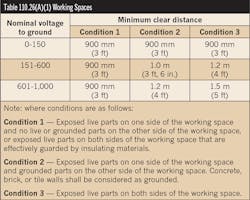What do today’s office buildings, hospitals, hotels, stores, and even schools have in common? Seemingly unrelated, this wide range of facility types all have the desire to drive maximum value from every bit of floor space they control. In today’s budget-conscious, bottom-line-focused business environment, wasting space is not an option.
How does this relate to electrical contractors? The spaces that house electrical equipment look increasingly different than they did 20, 10, or even five years ago. Many owners of commercial buildings, retail spaces, and other profit-generating organizations view electrical rooms as a necessary evil; they’re needed to house important electrical, climate control, and security equipment, yet they can’t be used to sell products, hold meetings, house patients, and so on.
Design trends
Electrical rooms are built to very specific code regulations designed to maximize the safety of the building’s occupants. To increase personal safety, recent National Electrical Code (NEC) changes now require more space around the equipment in the electrical room, presenting a dilemma for architects and owners hoping to maximize usable floor space.
Even with ever-evolving Code requirements, a recent trend in electrical systems design reveals a secret
to increased profits — converting square footage previously used for electrical equipment into revenue-producing space. By integrating electrical devices into fewer and smaller structures, manufacturers have been able to reduce the size of the electrical equipment, thereby helping owners and architects reduce the size of the electrical rooms.
On the surface, integrating electrical structures has its benefits — using less space for electrical equipment means there’s more space available for money-making activities to take place. In addition, integrating and condensing electrical spaces theoretically means less labor with everything in one space, as opposed to spread across several rooms in different locations in the facility. Therefore, there’s less of a need for electricians to work in different areas of the building.
This mind-set aligns with the wave of disruption in today’s business environment, with companies forced to re-examine old ways of doing things amidst the digital era. The past decade has brought about huge change in the areas of communications technology and energy efficiency for electrical equipment.
That said, another business tenet that cannot be forgotten — albeit the most important one — is worker safety. Productivity and revenue cannot be pursued at the expense of maintaining a safe work environment, yet with electrical rooms getting smaller and smaller (and with new technologies transforming the space), electrical contractors are faced with challenges around trying to install panels and transformers in tight spaces.
Challenges with today’s electrical rooms
Smaller footprints and condensed equipment rooms can create serious electric shock and arc flash hazards for electricians. But protecting workers from the hazards of electric shock is not a new consideration. Fortunately, more attention has been paid recently to the role electrical equipment can play in minimizing arc flash hazards. The energy exposure of an arc flash incident can be significantly reduced when there is more diligent monitoring of the type of equipment specified and where it is installed in an electrical system.
The 2017 edition of the NEC addresses arc energy reduction directly in Sec. 240.87. It requires arc energy reduction where the highest continuous current trip setting for which the actual overcurrent device installed in a circuit breaker is rated or can be adjusted is 1,200A or higher. If the overcurrent device in the circuit breaker meets this criteria, then documentation and a method to reduce the clearing time must be provided. NFPA 70E is also an essential reference for reducing arc energy, as an arc flash accident can render equipment unusable and place a facility in a costly downtime mode. Adhering closely to this code and standard is a necessary step to mitigating the risk of arc flash in all electrical rooms, but particularly those where space is tight and the risk is greater. This dedicated space provides the electrical worker the minimum area required to safely inspect, maintain, adjust, or service the installed equipment.
Walking the fine line between productivity and safety
After analyzing the risks inherent in maximizing revenue generation over safety, logical follow-up questions include: are contractors taking the necessary safety precautions in these electrical rooms, and, if not, how can they do so? What safety considerations should they keep top of mind? Let’s take a closer look.
While it’s true that integrating electrical equipment into smaller areas brings inherent risks, it’s not a method without solutions. To help explain, there’s no better place to look than the NEC — particularly Art. 110.
Section 110.13(B) sets standards around cooling, and requires that equipment installation allow free air movement through ventilation openings and that any marked separation distances from the equipment to walls and partitions are provided. The implementation of new technologies and designs, instead of just presenting risks, has actually reduced the amount of space necessary for cooling, because they produce far less heat. For example, new designs of low-voltage dry-type transformers have resulted in required separation distances as low as a half-inch on all sides, down from historic levels of 6 in. However, with less separation required between electrical equipment, this also means there is less space for electricians to move freely around equipment.
Section 110.26 details the minimum space requirements to permit safe operation and maintenance of electrical equipment. In 110.26(A), specific working space distances are provided where the equipment is likely to require examination, adjustment, servicing, or maintenance while energized. For enclosed electrical equipment, the depth of working space is measured from the enclosure surface. The manufacturer’s documents for the product will detail the access required, and often working space is not required on the sides and back of the enclosure because access is provided from the front.
The next question is: How much working space depth must be provided? Table 110.26(A) provides the answer based on the system voltage level and the applicable condition category (Table).
The easiest way to understand these categories is to use example installation scenarios. Let’s consider a common example of a 480/277V front-access switchboard installed in the electrical room of a commercial building or school. The working space required would be 3 ft (Condition 1), unless there are grounded parts or other electrical equipment on the other side of this working space. The installation condition criteria impacts how close the electrical equipment can be placed to other objects in the electrical room. Consider the case where there is a concrete wall on the other side of the working space. The concrete wall would be considered a grounded surface, so an additional 6 in. of working space (3 ft – 6 in. for Condition 2) must be provided.
Are transformers required to have working space? It depends upon the installation. Many transformers are installed without integral overcurrent protection devices and thus would not normally be considered as meeting the criteria of “likely to require examination, adjustment, servicing, or maintenance while energized.” However, there are many different transformer configurations, so the best approach is to discuss this issue with the authority having jurisdiction during the design phase of the project to ensure agreement.
What about the width of the work space? This one is much simpler. The width of the working space is either the width of the equipment or 30 in., whichever value is greater.
Going beyond codes for improved safety
The requirements in NEC Article 110, NFPA 70E and other codes should be considered the basic minimum installation requirements. Taking measures beyond these minimums should be considered and implemented as warranted. Consider some of the following tactics to enhance worker protection:
Risk assessment: For every new electrical room or piece of electrical equipment installed, contractors must conduct a thorough assessment of every risk involved. They need to understand the lay of the land, what the job entails, and physical hurdles beyond electrical equipment, secondary power supplies, and egress points in the case of an emergency. Proper planning prevents poor performance and helps keep people safe. Potential electrical hazard risks must also be determined in accordance with NFPA 70E with appropriate equipment marking to ensure workers are informed of the hazards present. The analysis of the arc flash energy levels within the power system can be extended to include actions to reduce these levels.
Personal protective equipment: First and foremost, it’s essential to provide PPE, lockout/tagout, and associated workplace practices in accordance with the risk assessment results. Contractors need to have the right protective equipment on hand that is aligned with the hazard level in case it escalates. Often, the configuration of equipment can be accomplished, which provides the redundancy needed to ensure all sources (including the line side) are removed before any work is done within electrical equipment.
Train, train, train: With all the change that has occurred in the industry over the past two decades, electrical contractors must invest time and resources to train their employees to work safely in these new work environments, putting effective safety measures and procedures in place to protect their employees from potential hazards. Education on “near miss” examples can help employees understand how they can stay safe and avoid disaster.
Maximizing revenue is not inherently a bad thing, and anyone who says differently is misguided. That said, problems can arise when making a profit takes precedence over everything else — namely the safety of the work environment. By aligning closely to — but going beyond — key industry codes for electrical safety, contractors can ensure they’ve done everything they can do to maintain a safe and secure work environment.
Kennedy is the manager of industry standards at Schneider Electric, based in Hopkins, S.C. He can be reached at [email protected].




